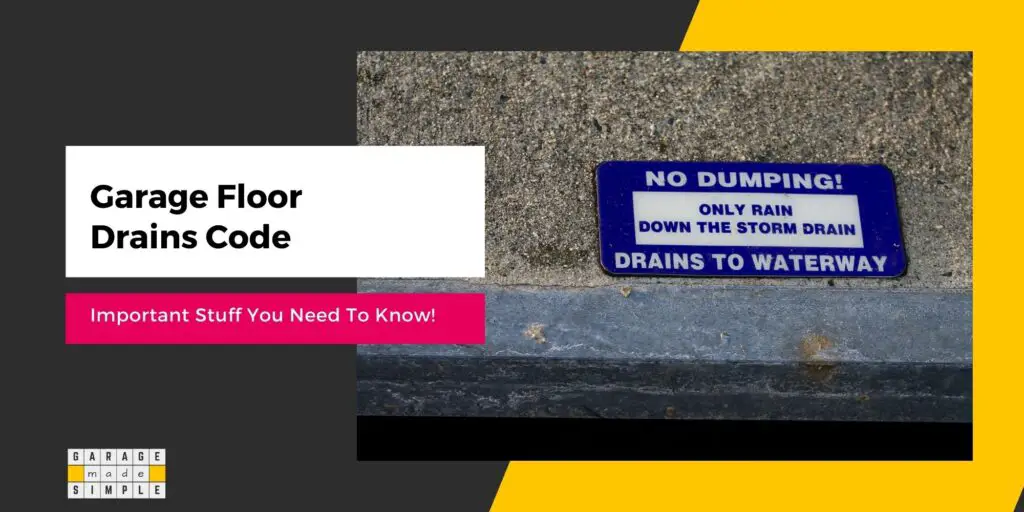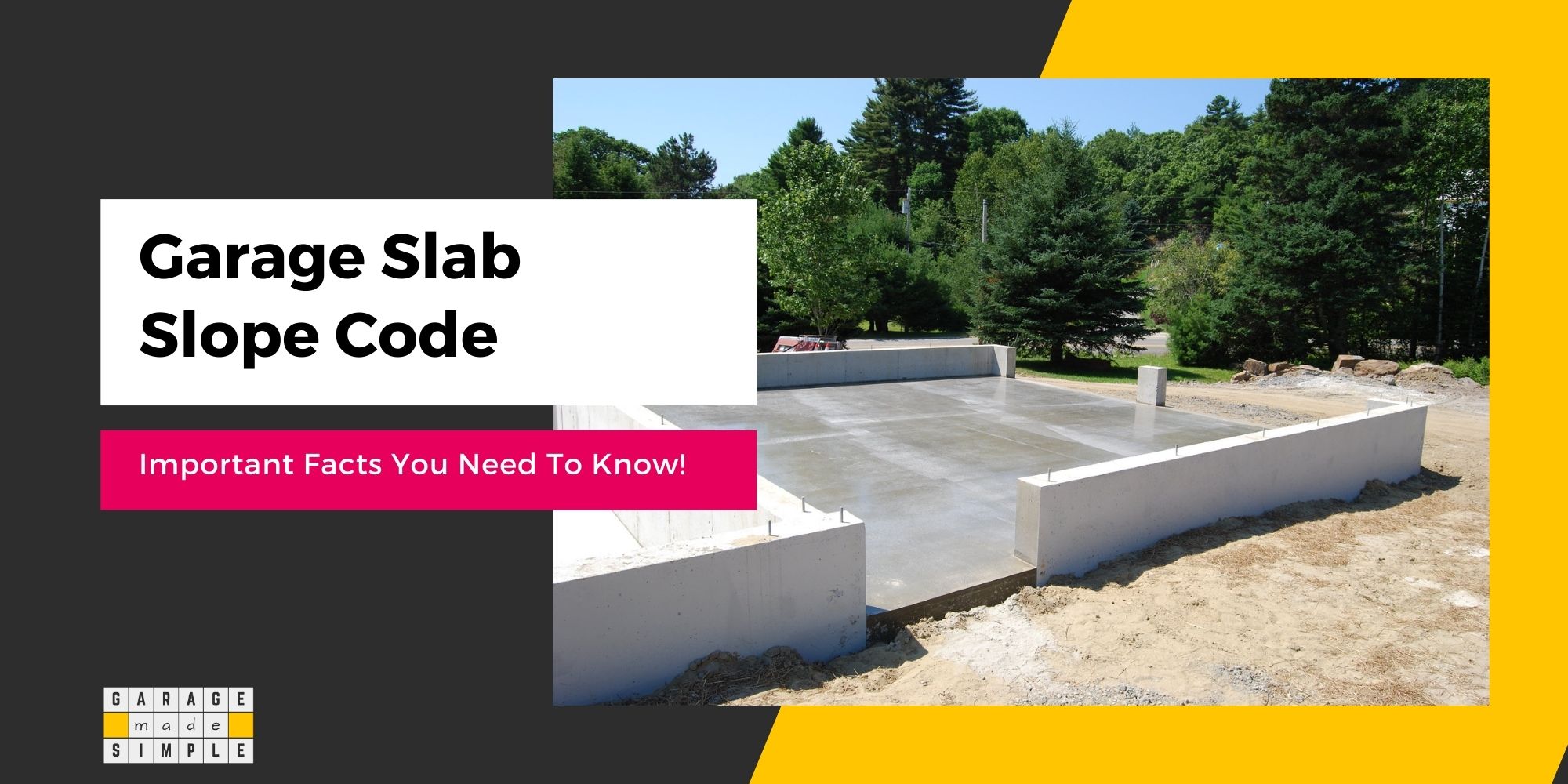Garage Floor Drains Code: 5 Useful Things Really Worth Knowing!
garagemadesimple.com is a participant in the Amazon Services LLC Associates Program, an affiliate advertising program designed to provide a means for sites to earn advertising fees by advertising and linking to Amazon.com . The website is also an affiliate of a few other brands. The affiliate links never increase your purchase price. We do appreciate your support. Thank you very much!
1. Are Garages Supposed to Have a Drain?
Do you have a garage which has a drain? But your neighbor has a garage that does not have a drain? So who is complying with the garage floor drains code? Are garages supposed to have a drain?
A garage may or may not have a drain as per the garage floor drains code. The 2021 International Residential Code (IRC) Section 309.1 only requires the garage floor to be sloped towards a drain or the garage door. A floor drain in the garage is helpful but not mandatory.
The exact wordings of 2021 International Residential Code (IRC) Section 309.1 are:
Garage floor surfaces shall be of approved noncombustible material. The area of floor used for parking of automobiles or other vehicles shall be sloped to facilitate the movement of liquids to a drain or toward the main vehicle entry doorway.
Without a floor drain in the garage, the only way water can flow out is through the garage door. The Code as per IRC does not prescribe a specific slope for the garage slab. This is left to the homeowner or contractor.
A pitch of ¼” for every foot is a commonly accepted norm. In %age terms this is around 2%. More specifically, for a 24’ deep attached garage, the door end will need to be 6” lower than the house end.
Depending on the lot, this may or may not be possible. Keep in mind that the driveway needs to continue sloping at the same rate to the curb, as well.
Often the required slope is incorporated in the design but not implemented in practice. With inadequate garage floor slope and uneven sinking of the concrete slab, the water either pools in the low spots or drains ever so slowly.

2. Why Does My Garage Have a Drain?
The best garage drainage solution is to have a set of floor drains on the garage floor to collect and direct the water out of the garage through correctly sloped drain channels or pipes.
There are many ways a garage floor gets wet. When you park your cars when it has been raining or snowing then they bring water or snow with them. The water drips and pools on the garage floor.
A garage tends to flood easily, as rainwater can flow in through the wide garage door. Water can also get in through the foundation walls in case the waterproofing is not very effective. And then there is always the risk of plumbing leaks.
Cars bring in dust, mud and muck into the garage. Sweeping and mopping helps keep your garage floor clean. But sometimes that is not enough. You may need to use the garden hose or even the pressure washer.
Naturally you can not do that if your garage does not have floor drains. Washing of cars within the garage is another reason to have garage floor drains.
Basically there are plenty of reasons why your garage should have a drain.
3. What Are the Types of Floor Drain?
When it comes to garage floor drains, the primary function is to catch the water on the floor and lead it to a drainage system through a sloping drain pipe or channel. It is therefore convenient to classify garage floor drains by the drain cover design.
There are three basic types of garage floor drains:
Square Drains
Square Drains have square or round perforated covers through which the water is collected. The concrete garage floor should pitch towards the Square Drain inlet from all four directions.

The drain grate, also known as a drain cover, blocks debris from entering your garage drainage system. As part of a complete drainage system, the drain grate drains water into a catch basin or low-profile adapter connected to a drain pipe
Depending on the size of your garage you can install several of them, spread evenly across the garage floor.
Trench Drains
As the name suggests, Trench Drains resemble trenches. They have a sturdy rectangular grating on top. Trench Drains can typically trap more water than Square Drains. The concrete garage floor is pitched towards the trench drain from the two long sides.
It is easier to install trench drains in existing garage floors as they are already built with a slope towards the garage door but without any drainage system.

In addition to installing them, spaced out within the garage, installed one along the garage door. This will prevent water puddles at the door and reduce risk of your garage door rusting.
You can also install a parallel trench drain outside on the driveway. This will catch most if not all of the rain water, in case of heavy downpour, before it enters and floods your garage floor.
U-Drain or Slot Drains
U-Drain or Slot Drains are basically just Trench Drains, but without the grate. Absence of the grate makes them look very sleek, even invisible. They are easier to clean too. You can insert a specially designed paddle and run it along the drain length.

The slot grate has an opening of 1/2 inch that widens towards the channel. This allows debris to pass through the slot and not be stuck.
4. Do Garage Floor Drains Have Traps?
Generally speaking, garage floor drains do not require traps as little or no organic waste is involved. Garage floor drains just need to collect the water and move it to the discharge point using gravity.
However, I would recommend adding a Sump Pit at the end of the garage floor drain network, before it joins with the main drainage system.

A Sump Pit is a big box, maybe 1 cubic foot, at the end (or even in between for long drains) of the drain pipe or channel, to collect the solid debris in the water. This helps to ensure the drain or channel does not get clogged.
The Sump has a lid or a cover, which can be opened from time to time, to clear the accumulated debris. The Sump Pit has an outlet that is connected to the discharge pipe. It can also accommodate a sump pump.
5. Where Does Drain in the Garage Go To?
Actually Garage Floor Drains can discharge only to the sanitary sewer drain system. Alternatively, you can have a Garage Floor Drain to Daylight. Discharge to the Storm Water Drain System is almost never permitted.
Knowing where the garage floor drain goes is important because garage floor drains are regulated by the local garage floor drains code.
The water that goes down a sink or toilet in your home or business flows through a sewer system to a wastewater treatment plant where it is treated and cleaned. Water that flows down a driveway or street and into a gutter goes into a storm drain which goes directly to a natural body of water, untreated.
EPA
You can read the EPA brochure by clicking here. The brochure makes it reasonably clear that garage floor drains should not discharge into the stormwater drains. Consider this as the garage floor drains code, if you will.
If your home is in a highly urbanized zone then discharging the garage water to the public sewer system may be your only option. However, if your home is on a large lot in a rural setting, garage floor drain to daylight is an option.
Local authorities may even encourage it. The load on the public sewer system reduces and the wastewater can be used to water the plants in your yard!
Thank you very much for reading the post. I do hope you found it informative and useful.






